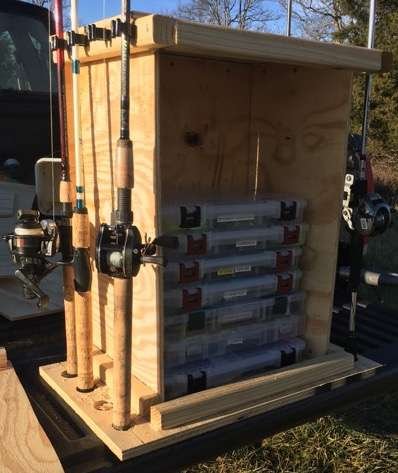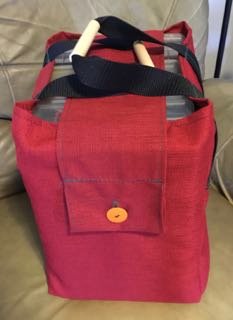
Elkins45
TU Member-
Posts
24 -
Joined
-
Last visited
Content Type
Profiles
Articles
TU Classifieds
Glossary
Website Links
Forums
Gallery
Store
Everything posted by Elkins45
-
The comments about the shaft being dirty are on the money.i had used these wires to hold some bodies when I painted them and didn’t clean them off when I used them to make baits. They have now been scraped clean and will be tried again. The one with the skirt definitely needs to be trimmed, I just didn’t want to ruin a skirt if the bait was bad for some reason...and now it may be that the I trimmed skirt is the reason it is bad I’ll report results after retesting.
-
-
I made a batch of inline spinners and these two just simply refuse to spin. Is there some obvious mistake I made? Can I modify them to make them work without cutting the wire and starting over, like maybe bending the blades or something?
-
Making a "HARDER" lead-head jig, drop shot sinker etc
Elkins45 replied to kbonanny's topic in Wire Baits
I cast more bullets than lures and have a lot of experience. If you can get your hands on an alloy with even a small percentage of antimony then you can get significant hardness just by water dropping. I cast almost everything from an alloy that is 96% lead, 2% tin and 2% antimony. Just dropping it from the mold into a bucket of water will cause the hardness to double. I have some bullet designs that perform very poorly when allowed to air cool but the groups tighten up considerably when water quenched. Clip on wheel weights do very well when water dropped, if you can still find any. Be extremely careful to keep water out of your molten lead or you will get a most unpleasant visit from the tinsel fairy! -
-
BPS has a nice rod and box storage rack but it isn’t designed for outdoor exposure. I wanted to make one for the boat so I used some scrap 3/8” plywood and a couple of 2x2s to make my own version. I added a sliding front door because I didn’t have any hinges. It needs some finish but I will probably wait until warmer weather to do that. The rod clips are from Amazon.
-
The mice got into the rod locker of my boat and had a little snack. The good news is that they picked the cheapest rod in it to eat. The bad news is that it's really not usable like this. How do I fix this?
-
From what I understand the carbohydrates in cedar or pine donate electrons to reduce the lead. Cheap hydrogenated shortening will do the same thing and smells a little bit like French fries. The only downside to using a surface layer is that you can’t drop your bad casts or cutoff sprues back into the pot because the stuff floating on top will get dragged down into the melt. If you decide to use a topper you just have to pour until empty and then refill the pot.
-
Each piece of yarn is actually four strands. I tied them on first and then unraveled them. This 12 strand version is about as dense as I would make one. I may make a couple of 8 strand versions to see if they give enough volume to the skirt. I can tell you a 24 strand version is really heavy when it gets wet. Cheapest skirt ever!
-
On a whim I tied up a jig using some short strands of acrylic yarn, the kind that you buy at the sewing store to know sweaters. I used too much, but the result was quite interesting. It gave the jig a lot of bulk and once you got it wet it added quite a bit of extra weight for greater casting distance. I’m going to tie up a couple of variations with lighter heads and fewer strands to see how they behave. I think tying them like the old “spider legs” spinnerbait skirts might be ideal. Anyone else try this?
-
Those snap connectors are a great idea, and I have a bunch of them from the straps that came off of my last worn out boat cover.
-
The only downside is that it doesn’t keep the rain out of the boxes.
-
-
That’s a better idea than mine. I guess it’s time for version 3nkw.
-
I added a handle. The "real bag has a dual so it isn't tippy, but I think a single will do OK, especially since it wraps all the way around.
-
I also bought some different fabric to try. This is polyester fleece and I just sewed it into a simple bag. I figured that since it's not waterproof it doesn't make any sense to add a lid. I'm just going to add a retention strip like on the original Flambeau tote, but secure it with a button instead of velcro. When it rains I can just turn it sideways and that should keep everything dry. Oh, and of course I'm going to add handles too. I just didn't have any nylon webbing lying around. Once I worked out the correct dimensions it was easy to cut out and put together a couple of different bag bodies. I made another one from a weatherproof canvas I found at the fabric store. If you don't have a sewing machine I feel confident you could build one of these bags by gluing the fabric together with epoxy, or even hand stitch it.
-
I didn't know where to put this, so moderators please move it if you think it would fit better elsewhere. I have a Flambeau Tackle Tote that was made to organize and transport the plastic boxes we all use. Unfortunately it has two flaws to my mind: 1) It holds the boxes vertical so rain can penetrate under the lid edges. If you forget and leave the box exposed in your boat you can end up with some rusty hooks. 2) They are like $18 each, which is a lot for some cloth, webbing and a strip of velcro. I decided I wanted to improve the design and make my own. Walmart sells a fabric called Pro Tuff Outdoor Fabric that is a canvas with a waterproof backing. I looks like it would be strong, waterproof and UV resistant. It was also quite reasonably priced at $4.97/yard. I picked up 1.5 yards and a spool of polyester heavy-duty upholstery thread. Step one was to figure out the dimensions. I settled on a bag that will hold six large boxes tightly or five with some rattle room. For my first iteration I made a bag with a single strip that was to be wrapped around and form the front, bottom, back and top. As it turns out this wasn't the best design because it makes the top strip too narrow and it leaves the top with unhemmed edges. The second try was made from four pieces, which are: main piece (1) 12" x 42.5" sides (2) 10.5" x 16" top (1) 15" x 21" After cutting the material, begin by sewing the sides to the bottom to form "wings." This material has two distinct sides, so pay attention that the rubberized sides all face the correct direction before sewing them in place. The next step is to stitch the four side seams, then hem the top all the way around. Now turn it inside out and this completes the bag. The next step is to hem all around the top piece, with a big overlap on the front where the button holes go. Then make the button holes. Now, sew the top to the bag, mark the button locations and sew on the buttons. As you can see, the top is intentionally wider than the bag. This gives a nice overhang to keep the water from dripping into the sides. The first version where I integrated the top doesn't have that advantage and it came out all funky. My next step is to get some webbing and sew on handles.
-
If the problem is zinc contamination some bullet casters have managed to remove it with sulfur. The zinc forms zinc sulfide and can be scraped off the top. I question whether it would be worth the trouble or expense. I’m sorry if you said and I missed it, but did the lead act funny when you were making the ingots?
-
Shielding lead is usually just pure soft lead. Do you know how hot you are getting it? I suppose it's possible that you found a batch of shielding that was alloyed with something else, but even in that case it would eventually all get scooped off. Does your pot still work OK with a different batch of ingots?
-
This sounds more like you pot isn’t getting hot enough.
-
I don’t love sawdust, but if you leave it in and keep stirring until it completely chars to powder then you can spoon all the junk off with the powder. Rosin is the best because it melts into a gummy goo before it burns and all the junk sticks to it. If I could only have one flux it would be rosin. But if I’m just cleaning dirty wheel weights or plumbing lead I do it over a burner outside and I will use any old garbage like old experimental bullet lube sticks, sawdust, Crisco or even used motor oil. Indoors in my casting furnace rosin or shortning are all I use because the work best and stink least. The best judge of how well your flux is fluxing is how heavy your dross is. I keep a soup can to catch it and it used to be that a full can felt like it weighed 10 pounds. Once I switched to rosin the can got a lot lighter—-I’m skimming off more junk and losing less good metal. I cast about 500 pounds of bullets a year, so I do a lot of fluxing.
-
If you are spooning off the oxides then it really isn’t acting as a true flux. It’s just helping with cleaning the metal. A true flux actually reduces the oxides back to the elemental metal and back into the melt. That’s why cheap partially hydrogenated shortning or rosin- heavy woods are good—they have an H+ available to pull off the O. That reminds me: rosin makes a really great flux and it smells good too. It also helps protect your pot from rust. Also, I’m not all that enthusiastic about inhaling boron fumes.
-
Cheap vegetable shortning is about as good as it gets. Gulfwax is also good, but the smoke is kind of gaggy. Shortning smells like French fries. Sawdust is OK...the Cast Boolets guys love it, but I think shortning is better. The cheaper brands are the best because they are partially hydrogenated Avoid Marvelux at all costs. The crusty residue it leaves behind will attract water and rust your pot. It’s the only bad product Brownell’s sells.
-
I’m a bullet caster of many years experience, and my experience has always been that alloys containing some tin or antimony cast easier and fill out better. The hardest bullet to cast is usually a pure soft lead bullet for muzzle loading rifles. I was genuinely perplexed when I read the instructions for Do-it molds that said pure lead casts better. To cast a good pure lead bullet I generally have to get the melt and the mold crazy hot and cast as fast as possible. My experience making jigs has been the same.



.thumb.jpg.10792ec89f67ceb31257d83e6ed657ab.jpg)










